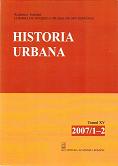Despre extinderea reţelei de sucursale şi agenţii a BNR (1880–1930)
The Spread of Branches and Agencies of the National Bank of Romania (1880–1930)
Author(s): Mihaela Tone, Cristian PăunescuSubject(s): History
Published by: Editura Academiei Române
Keywords: National Bank of Romania; bank branches; territorial network;
Summary/Abstract: In 1880 the National Bank of Romania was founded as a business stock corporation having both state and private share capital of lei 30.000.000 and it was assigned the privilege to issue banknotes. According to the Foundation Act, the National Bank was to open branches in each county capital and wherever necessary, the first such locations being Jassy, Galaţi, Brăila and Craiova. After the first Governor (Ion I. Câmpineanu) was appointed and the memberships of the first management boards were nominated (the Board of Directors and the General Board), the next step was to employ the bank officers in charge with organizing the first four branches, which started to operate in 1881. For the commencement of the branch operations, several measures were taken, such as: the supply of the necessary banknote stock, the deposit of guarantees by the bank officers and establishment of the salaries thereof, the evaluation of the Commerce Funds and of the persons acceptable for discount purposes, the rent of the office premises, the enactment of the Branch Internal Rules. Gradually, the NBR involvement in the local economic life continuously increased by extending both the amount of operations and its territorial network of branches and agencies. Thus, before the World War 1 decisions were made in several steps for the establishment of new NBR agencies, which started to operate as follows: Botoşani, Bârlad, Focşani, Ploieşti (1890); Turnu Severin (1892), Buzău, Constanţa (1893); Bacău, Piteşti (1894); Caracal, Roman, Turnu Măgurele (1897); Dorohoi, Piatra-Neamţ, Tulcea (1898); Giurgiu, Târgu Jiu (1899); Râmnicu Vâlcea, Târgovişte (1902); Fălticeni (1903); Călăraşi, Râmnicu Sărat, Giurgiu, Tecuci (1905); Câmpulung - Argeş, Huşi, Vaslui (1906); Silistra (1913); Bazargic (1914). The opening of the agencies added to the concern of the NBR management with building up bank’s own premises, the architecture and the location of such premises having significant influence on the evolution of those urban areas in terms of city planning. That aspect of the local city planning history is shown in a case study on the Buzau NBR Agency, which resulted from a research on the ownership documents preserved in the NBR Archives, as well as from reference to a postcard collection featuring pictures of the NBR offices, which have recently been acquired for the Historical Picture Collection of the same institution. After the World War 1 the NBR network of branches and agencies also expanded in Transylvania, Bukovina and Bessarabia, the number thereof reaching 70 in 1930. Although the opening and operation of a central bank office is a small history detail, unique of its kind, broadly speaking one may say that the foundation and the expansion of the National Bank network of branches and agencies was a process with many consequences on the pace of the economic development and on city planning transformations in the towns where they operated.
Journal: Historia Urbana
- Issue Year: XV/2007
- Issue No: 1+2
- Page Range: 87-101
- Page Count: 15
- Language: Romanian
- Content File-PDF

